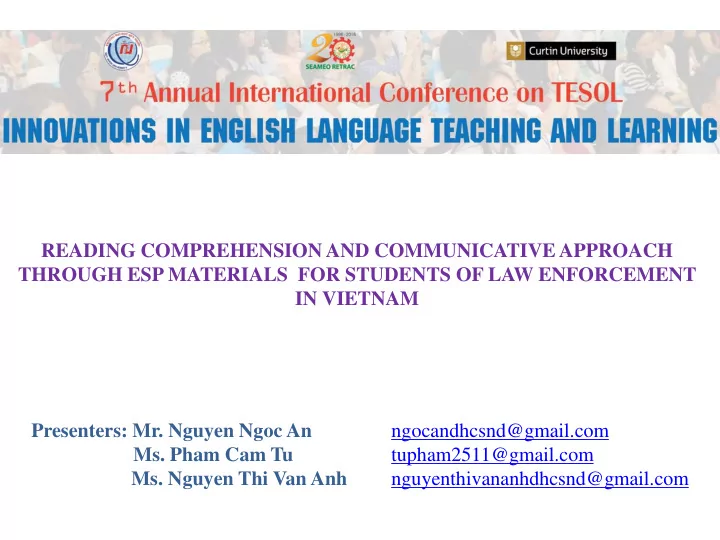

READING COMPREHENSION AND COMMUNICATIVE APPROACH THROUGH ESP MATERIALS FOR STUDENTS OF LAW ENFORCEMENT IN VIETNAM Presenters: Mr. Nguyen Ngoc An ngocandhcsnd@gmail.com Ms. Pham Cam Tu tupham2511@gmail.com Ms. Nguyen Thi Van Anh nguyenthivananhdhcsnd@gmail.com
What is ESP? nglish for E S pecific P urposes
The characteristics of ESP 3 absolute characteristics: - Learners' specific needs; - Use of the underlying methodology and activities of the discipline - Centering on the language with grammar, lexis, register 4 variable characteristics: - Designed for specific disciplines, - Used in specific teaching situations, - Designed for adult learners or professional work situations, - Assumed some basic knowledge of the language system Dudley-Evans & St. John (1998) , and Strevens (1988)
The communicative approach ESP materials
THE PURPOSE OF RESEARCH 1- Analyze the effects of applying reading through ESP materials by using the communicative approach. 2 - Encourage students' use of English to debate law topics. 3 - Increase the students' acquisition of vocabulary.
THE RESEARCH QUESTIONS 1. What might be the effects of applying reading through ESP materials by using the communicative approach to a group of senior students from the law enforcement course at PPU, Ho Chi Minh City? 2. In what way does reading under ESP materials help students to gain better knowledge of their own field of study? 3. How does reading under ESP texts enable students to discuss topics of law? 4. How does reading about topics of law contribute to students' acquisition of specialized vocabulary?
Participants 40 senior students in Law Enforcement Course f - D23S at the People’s Police University in Vietnam. The reasons: • studying at the author’s university • the same age & speak Vietnamese as their first language • have studied general English at higher level at PPU (with the same course book) • studied in high school for seven years before entering to
Researching Instrument semi-structured interviews researchers' journals
Implementing - Procedure Time: Three months 1. Present the project to students and explained the benefits of participating with regard to experience and knowledge acquisition. 2. Give a bank of law texts (including authentic ESP documents and books) was gathered from the library (the topics that generated discussion and analysis among the students included: criminal law, international law, human rights, the consumption of drugs, crime scene, and crime and the justice system in other countries). 3. Explain to students, by way of examples, the processes of reading (pre-reading, while-reading, and post-reading) and the reading techniques to be used throughout the project. Then, researcher asked students read specialized texts and prepared presentations (written and oral); sometimes they had to read extra information to defend their position in front of the group or the teacher. Moreover, they had to be ready to answer questions that clarified their viewpoints.
Result : From the semi-structured interviews: - had motivated students’ acquisition of knowledge - understand specific aspects of other countries’ legislation In the journal: - Students were engaged in acquiring information in their own field of study. -Students used their prior knowledge and acquired new knowledge when arguing about different legal topics. - Students gained fluency when talking about the different topics of their own fields of study. - Students acquired a lot of specific vocabulary and commonly used phrases pertaining to law.
Encourages students to investigate information related to their own needs in foreign countries Motivated the students' use of prior knowledge as a relevant source to defend their ideas in front of their peers Opportunity for students to become familiar with reading techniques that permitted them access to topics of law written in English .
REFERENCES Anthony, L. (1997). Genre analysis and it applications for ESP materials. Paper presented at the MA TEFL Summer Seminar of the Birmingham University, Hiroshima, Japan . Anthony, L. (2007, October). The teacher as student in ESP course design. Keynote address presented at the 2007 International Symposium on ESP & Its Applications in Nursing and Medical English Education, Fooyin University, Kaohsiung, Taiwan. Burns, A. (2003). Collaborative action research for English language teachers. Cambridge, UK: Cambridge University Press. Butler-Pascoe, M. E. (2009, June). English for specific purposes (ESP), innovation, and technology. English Education and ESP , 1-15. Dudley-Evans, T., & St John, M. J. (1998). Developments in English for specific purposes: A multidisciplinary approach. Cambridge, UK: Cambridge University Press . Gatehouse, K., (2001). Key issues in English for specific purposes (ESP) curriculum development. The Internet TESL Journal , 7(10). Hutchinson, T., & Waters, A. (1987). English for specific purposes. Cambridge, UK: Cambridge University Press. Silverman, D. (1993). Interpreting qualitative data. London, UK: Sage Publications . Strevens, P. (1988). ESP after twenty years: A reappraisal. In M. Tickoo (Ed.), ESP: State of the art (pp. 1-13). Singapore: SEAMEO Regional Centre. Torregrosa, B., & Sanchez-Reyes, S. (2011). Use of authentic materials in the ESP classroom. Encuentro: Revista de Investigacion e Innovacion en la Clase de Idiomas , 20, 89-94.
Thank you for your listening Q & A Mr. Nguyen Ngoc An ngocandhcsnd@gmail.com
Recommend
More recommend